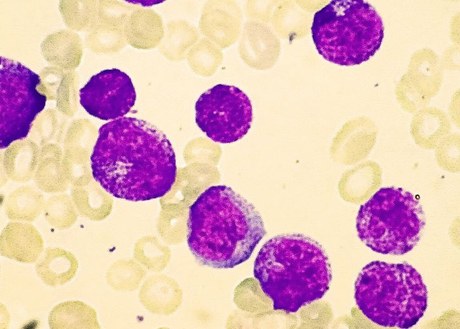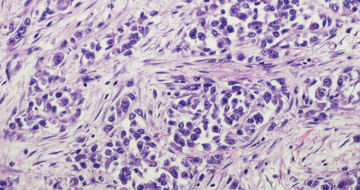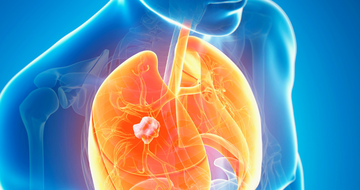What is the potential role for olutasidenib in the treatment of R/R IDH1+ AML?
- Olutasidenib is a small molecule inhibitor that targets the mutant isocitrate dehydrogenase 1 (IDH1) enzyme. IDH1 mutations are implicated in increasing levels of 2-hydroxyglutarate (2-HG) in leukemia cells, which prevents further myeloid cell differentiation in AML. Inhibition of IDH1 by olutasidenib leads to decreased 2-HG levels, induces myeloid differentiation, and results in in-vivo reduced blast counts and increased percentages of normal myeloid cell production in IDH1 mutated AML.1
- Olutasidenib is a National Comprehensive Cancer Network (NCCN) category 2A recommendation for R/R AML with an IDH1 mutation. Other therapies that may be considered in this line of therapy include ivosidenib (also an IDH1 inhibitor), hypomethylating agents (with or without venetoclax), or cytotoxic chemotherapy regimens (e.g., FLAG, MEC, etc.).2
- The FDA approval was based on a single-arm, multicenter, phase I/II study in a cohort of adult patients with R/R AML with an IDH1 mutation (Study 2102‐HEM‐101). The phase II portion of the study included multiple cohorts (AML and MDS)3,4:
- Patients in the R/R AML cohort (n=153) were required to have a centrally confirmed IDH1 mutation, adequate organ function, Eastern Cooperative Oncology Group (ECOG) performance status of 0-2, and a QTcF <450 milliseconds.
- Olutasidenib was given orally at a dose of 150 mg twice daily in continuous 28 day cycles.
- The primary outcome, the rate of complete remission (CR) or complete remission with partial hematologic recovery (CRh), was 35%, with a 32% CR rate. Median time to first response was 1.9 months.
- Responses were maintained in the small number of patients previously treated with venetoclax (CR/CRh = 33%).
- Median OS was 11.6 months in the overall population.
- Common adverse effects included nausea (38%), constipation (26%), leukocytosis (25%), fatigue (23%), febrile neutropenia (22%), anemia (25%), thrombocytopenia (20%), and neutropenia (13%). Grade 3/4 adverse effects included febrile neutropenia (20%), anemia (20%), thrombocytopenia (16%), and neutropenia (13%).
- Differentiation syndrome was reported in 14% of patients and was grade 3 or higher in 9% of patients. The majority of differentiation syndrome events occurred in the first two cycles (median time to event 17.5 days [range 1-561]).
- Hepatic adverse events (most commonly LFT elevations) occurred in 25% of patients and were grade 3 or higher in 15% of patients.
- Patients in the R/R AML cohort (n=153) were required to have a centrally confirmed IDH1 mutation, adequate organ function, Eastern Cooperative Oncology Group (ECOG) performance status of 0-2, and a QTcF <450 milliseconds.
- The response rates and safety profile of olutasidenib are similar to ivosidenib, the other FDA approved IDH1 inhibitor. Ivosidenib results in a CR/CRh rate of 30.2% in R/R IDH1+ AML.5
- Differences in baseline characteristics make cross-trial comparison of these single-arm trials problematic. Both ivosidenib and olutasidenib are appropriate options for IDH1+ AML in the R/R setting.2
- Ivosidenib and olutasidenib both may produce differentiation syndrome, but ivosidenib causes QTc prolongation and olutasidenib may result in hepatotoxicity.
What role can the pharmacist play in the management of patients on olutasidenib? 1-4
- Pharmacists can help select appropriate patients for olutasidenib (including recommending IDH1 testing). Advantages include the low rate of cytopenias compared to cytotoxic chemotherapy and the lack of QTc prolongation compared to ivosidenib. Disadvantages include the long time to response of IDH inhibitors in general, drug interactions, and hepatotoxicity.
- Pharmacists can manage drug interactions with olutasidenib.
- Pharmacists play a vital role in grading and management of toxicities of olutasidenib, including hepatotoxicity and differentiation syndrome.
- Patients should be counseled on the signs and symptoms of differentiation syndrome, including fever, cough or difficulty breathing, decreased urinary output, low blood pressure, weight gain, or swelling. Patients should seek immediate attention if signs or symptoms occur.
Clinical Pearls
- Differentiation syndrome most commonly occurs in the first several cycles; however, this can occur at any point in therapy (even months-years after beginning treatment).1
- If differentiation syndrome occurs, administer systemic corticosteroids and consider holding olutasidenib depending on clinical severity (half-life is approximately 67 hours so holding may not be as effective as corticosteroid administration).
- Olutasidenib is a substrate of CYP1A2 (minor), CYP2C9 (minor), CYP2C19 (minor), and CYP3A4 (major, ~90%). Olutasidenib induces CYP3A4, CYP2B6, CYP1A2, CYP2C8, CYP2C9.1
- Olutasidenib may penetrate the CNS and is also of interest in IDH1-mutant gliomas.6
- Both FDA approved IDH1 inhibitors (ivosidenib and olutasidenib) are costly oral oncolytics (approximately $30,000/month).7 A copay assistance program exists for olutasidenib: https://rezlidhiacopay.com/.8
References
1.Rezlidia (olutasidenib) [prescribing information]. Greenville, SC: Forma Therapeutics, Inc.; 2022.
2.National Comprehensive Cancer Network. Acute Myeloid Leukemia (Version 3.2023). https://www.nccn.org/professionals/physician_gls/pdf/aml.pdf. Accessed June 30, 2023.
3.de Botton S, Fenaux P, Yee KWL, et al. Olutasidenib (FT-2102) induces durable complete remissions in patients with relapsed or refractory IDH1-mutated AML. Blood Adv. 2023;7(13):3117-3127. doi: 10.1182/bloodadvances.2022009411.
4.Watts JM, Baer MR, Yang J, et al. Olutasidenib alone or with azacitidine in IDH1-mutated acute myeloid leukaemia and myelodysplastic syndrome: phase 1 results of a phase 1/2 trial. Lancet Haematol. 2023;10(1):e46-e58.
5.DiNardo CD, Stein EM, de Botton S, et al. Durable remissions with ivosidenib in IDH1-mutated relapsed or refractory AML. N Engl J Med. 2018;378(25):2386-2398. doi: 10.1056/NEJMoa1716984.




